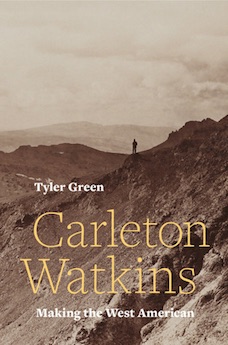By Svetlana Alpers
I had great expectations for this book. There is the wonderful idea of using the inside of the dust jacket, when removed and unfurled as it were, for a splendid iconic Carleton Watkins photograph of El Capitan at Yosemite. But the story told within was for me quite unexpected. And indeed aside from the dust jacket just described it is text rather than images that provides the major interest. Watkins (1829-1916), born in Oneonta in the Catskills and dying in California’s Napa Valley, was a great pioneering photographer of the West. But a lot is hidden under the subtitle “Making the West American.” Starting with the Gold Rush, California is a land where Indians had lived that had been part of Mexico but is then taken over, settled, and developed by Americans like Watkins crossing the country from the east.
When not yet twenty, Watkins made the long trip by boat to San Francisco. He did not know what he would do, and eventually found himself working as a retail clerk. His first known photograph, made in 1858, is a panorama of Sierra del Encino showing a tract of land with a single large oak to either side. It won the case a mining company presented in court for ownership of the land. Watkins often appeared in court with his photographs as testimony. As Watkins started, so he was enabled to continue—first with mining, then with railroads, and finally with big agriculture. In California all of that was big business supported, in a way that Americans have tended to forget, not only by private investment, but also by big government. Lugging his specially designed huge camera about, and finally travelling with it in the dedicated car of a train, Watkins, as the author says, “created a series of photographs that changed American art and impacted the nation’s history.“
But what is astonishing is to learn, and indeed with his photographs to see, that the celebration of the beauties of the land went along with the destruction of the land first by mining companies and then by railroads. The same investors financed both: the beauties of the land were the stretches that money and business left untouched. What Watkins celebrated can be thought of as land leftover from the businesses that financed him.
The tone of the book is, however, very different. Tylor Green discovered in the course of his work that his own great-great-grandfather was the investor who supported Watkins through the last third of his career. The book is celebratory in tone even as this reader was surprised by what was being revealed. In 1876, six months after a bank collapse and the death of one of his supporters, Watkins is up on a building in San Francisco making a portrait of The Nevada Bank Building. In the 1870s, when the Comstock Lode was being worked, there is Watkins photographing. Green gives us the financial figures for the mining of silver, which it is true had been essential financing for the Union victory in the Civil War. We can look at the 1876 photograph of the Bullion Mine, Virginia City, Nevada, with its squat wooden building and tiny houses perched against and beneath a rough hill. Its owner, we are told, made no money from it but made his first fortune in flipping it. It is suggested that maybe the photograph was commissioned to commemorate the owner’s acumen as an investor. Well, so it goes. I found it tricky to hold on to the obvious interest and beauty in photographs of the land while the text tells another story. It seems, though the book does not say it, that there is something escapist about the iconic photographs of wilderness by Watkins. A painting would not be seen as an escape but as an act of the imagination. Is there something we assume about paintings we do not or cannot assume of photographs?
Reviewer Svetlana Alpers, an artist, critic, and renowned art historian, is professor emerita of the history of art at the University of California, Berkeley and a visiting scholar in the Department of Fine Arts at New York University.




